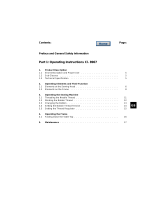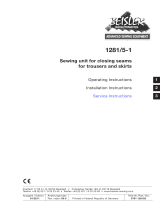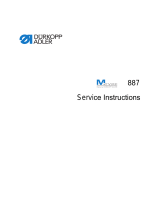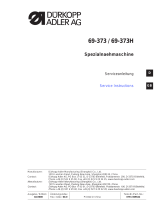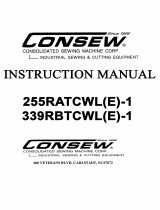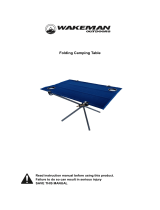Page is loading ...

Contents Page:
Service Instructions Cl. 381/382
1. General
1.1 Gauge set . . . . . . . . . . . . . . . . . . . . . . . . . . . . . . . . . . . . . . . . . . . . . . . 4
1.2 Description and adjustment of the integrated adjusting disk . . . . . . . . . . . . . . . . . . . 4
1.3 Position of the integrated adjusting disk in relation to the arm shaft . . . . . . . . . . . . . . . 5
1.4 Position of the lower toothed belt pulley . . . . . . . . . . . . . . . . . . . . . . . . . . . . . . . 6
2. Distance between the needle bar and the cloth presser bar
3. Position of the needle in the stitch hole . . . . . . . . . . . . . . . . . . . . . . . . . . . . . 8
4. Synchronism of the needle and of the lower feed . . . . . . . . . . . . . . . . . . . . . . . . 9
5. Feed dog height . . . . . . . . . . . . . . . . . . . . . . . . . . . . . . . . . . . . . . . . . . . 10
6. Aligning the feed dog . . . . . . . . . . . . . . . . . . . . . . . . . . . . . . . . . . . . . . . . 11
7. Position of the lifting eccentric . . . . . . . . . . . . . . . . . . . . . . . . . . . . . . . . . . 12
8. Upper puller feed
8.1 Synchronism of the lower feed and upper puller feed . . . . . . . . . . . . . . . . . . . . . . . 14
8.2 Distance between the puller and the needle . . . . . . . . . . . . . . . . . . . . . . . . . . . . 15
8.3 Puller lifting stroke . . . . . . . . . . . . . . . . . . . . . . . . . . . . . . . . . . . . . . . . . . . 16
8.4 Puller pressure . . . . . . . . . . . . . . . . . . . . . . . . . . . . . . . . . . . . . . . . . . . . . 17
8.5 Fabric repeller . . . . . . . . . . . . . . . . . . . . . . . . . . . . . . . . . . . . . . . . . . . . . 18
8.6 Toothed belt tension of the upper puller feed . . . . . . . . . . . . . . . . . . . . . . . . . . . . 19
8.7 Replacing the puller
9. Needle bar height . . . . . . . . . . . . . . . . . . . . . . . . . . . . . . . . . . . . . . . . . . . 20
10. Sewing foot height and sewing foot lift
10.1 Height of the cloth presser bar . . . . . . . . . . . . . . . . . . . . . . . . . . . . . . . . . . . . 21
10.2 Foot lift, mechanical . . . . . . . . . . . . . . . . . . . . . . . . . . . . . . . . . . . . . . . . . . 22
10.3 Foot lift, electropneumatic (autom. sewing foot lift) . . . . . . . . . . . . . . . . . . . . . . . . 23
10.4 Sewing foot power . . . . . . . . . . . . . . . . . . . . . . . . . . . . . . . . . . . . . . . . . . . 24
11. Thread guiding parts
11.1 Releasing the upper thread tension . . . . . . . . . . . . . . . . . . . . . . . . . . . . . . . . . 25
11.2 Thread tightening spring . . . . . . . . . . . . . . . . . . . . . . . . . . . . . . . . . . . . . . . 26
12. Bobbin winder . . . . . . . . . . . . . . . . . . . . . . . . . . . . . . . . . . . . . . . . . . . . 27
13. Hook adjustments
13.1 Loop stroke and distance of the hook tip to the needle . . . . . . . . . . . . . . . . . . . . . . 28
13.2 Bobbin case lifter . . . . . . . . . . . . . . . . . . . . . . . . . . . . . . . . . . . . . . . . . . . 29
GB

Contents Page:
14. Thread cutter
14.1 Adjusting the control cam . . . . . . . . . . . . . . . . . . . . . . . . . . . . . . . . . . . . . . 30
14.2 Adjusting the thread cutter magnet . . . . . . . . . . . . . . . . . . . . . . . . . . . . . . . . . 31
14.3 Adjusting the roller bolt . . . . . . . . . . . . . . . . . . . . . . . . . . . . . . . . . . . . . . . 31
14.4 Timing the knife movement . . . . . . . . . . . . . . . . . . . . . . . . . . . . . . . . . . . . . 32
14.5 Height of the hook shaped knife and lateeral distance to the throat plate . . . . . . . . . . . . 33
14.6 Position of the hook shaped knife in relation to the counter knife . . . . . . . . . . . . . . . . 34
14.7 Cutting pressure . . . . . . . . . . . . . . . . . . . . . . . . . . . . . . . . . . . . . . . . . . . 35
14.8 Adjusting the thread clamp position . . . . . . . . . . . . . . . . . . . . . . . . . . . . . . . . 35
14.9 Thread clamp pressure . . . . . . . . . . . . . . . . . . . . . . . . . . . . . . . . . . . . . . . 36
14.10 Transmission rods for the action of the hook shaped knife . . . . . . . . . . . . . . . . . . . . 37
15. Needle bar crank and disconnectable needle bars
15.1 Removing the needle bar crank . . . . . . . . . . . . . . . . . . . . . . . . . . . . . . . . . . . 38
15.2 Removing a needle bar from the crank . . . . . . . . . . . . . . . . . . . . . . . . . . . . . . . 39
15.3 Stripping a needle bar . . . . . . . . . . . . . . . . . . . . . . . . . . . . . . . . . . . . . . . . 40
15.4 Assembling a needle bar . . . . . . . . . . . . . . . . . . . . . . . . . . . . . . . . . . . . . . . 40
15.5 Fitting the needle bars into the needle bar crank . . . . . . . . . . . . . . . . . . . . . . . . . 41
15.6 Fitting the needle bar crank . . . . . . . . . . . . . . . . . . . . . . . . . . . . . . . . . . . . . 43
16. Changing the sewing equipment . . . . . . . . . . . . . . . . . . . . . . . . . . . . . . . . . 44
17. Changing the toothed belt . . . . . . . . . . . . . . . . . . . . . . . . . . . . . . . . . . . . . 45
18. Lubrication
18.1 Oil circulation . . . . . . . . . . . . . . . . . . . . . . . . . . . . . . . . . . . . . . . . . . . . . 47
18.2 Hook-drive lubrication . . . . . . . . . . . . . . . . . . . . . . . . . . . . . . . . . . . . . . . . 48
19. Sewing motors . . . . . . . . . . . . . . . . . . . . . . . . . . . . . . . . . . . . . . . . . . . . 49
19.1 Sewing motor control unit DA82GA . . . . . . . . . . . . . . . . . . . . . . . . . . . . . . . . . 49
19.2 Sewing motor control unit 6F82FA . . . . . . . . . . . . . . . . . . . . . . . . . . . . . . . . . 49
19.3 Positioning . . . . . . . . . . . . . . . . . . . . . . . . . . . . . . . . . . . . . . . . . . . . . . 49
19.4 Setting the machine specifical parameteres . . . . . . . . . . . . . . . . . . . . . . . . . . . . 49
19.5 Masterreset . . . . . . . . . . . . . . . . . . . . . . . . . . . . . . . . . . . . . . . . . . . . . . 49
19.6 Parameter list . . . . . . . . . . . . . . . . . . . . . . . . . . . . . . . . . . . . . . . . . . . . . 49
20. Maintenance . . . . . . . . . . . . . . . . . . . . . . . . . . . . . . . . . . . . . . . . . . . . . 50
21. Optional equipment
21.1 Thread wiper . . . . . . . . . . . . . . . . . . . . . . . . . . . . . . . . . . . . . . . . . . . . . 51
NOTE !
The pictures shown in the present manual are originating from
different special machine classes or sub-classes.
Please note that your special sewing machine may deviate from the
picture.

1. General points
The present Service Instructions 381-382 are describing the
adjustment of the special sewing machine.
381-160161 Twin needle flat bed double lockstitch machine
with disconnectable needles, lower feed and
needle feed, electromagnetic thread cutter
381-160162 as cl. 381-160161, but additionally with an automatic
electropneumatic -
bartacking mechanism and electropneumatic
sewing foot lift
382-160162 as cl. 381-160162, but additionally with puller feed
NOTE !
The actions described in the present Manual should be carried out
exclusively by specialists or by the properly qualified staff. !
Caution: Danger of bodily injuries !
Turn off main switch and disconnect the machine from the pneumatic
supply line when proceeding to repairs, transformations or
maintenance.
Any adjustment work and function tests on the running machine should
be carried out very carefully and noting all safety precautions.
The present Service Instructions are describing in proper sequence
the adjustment of the sewing machine. Please note that the different
adjustment positions are interdependent. Therefore, it is absolutely
necessary to follow the described sequence.
Introduce a new perfect needle before proceeding to the adjustments
of the stitch forming parts.
3
GB

1.1 Gauge set
The following seting gauge enables a precise adjustment and checking
of the sewing machine.
Position Setting gauge Ref. no. Use
1 Setting pin 9301 022608 Locking the tracing positions
1.2 Description and adjustment of the integrated adjusting disk
By means of the locking pin 3 and by the disk 1, flanged to the toothed
belt pulley of the arm shaft, it is possible to lock the sewing machine in
all adjustment positions.
The adjusting disk provides for this purpose 5 incisions.
The incision I (loop stroke position) is deeper than the other incisions.
Set in the individual positions:
I The adjusting disk in relation to the groove of the arm shaft crank,
loop stroke,
The distance of the hook tip in relation to the needle, the puller
action moment: the groove of the eccentric on the groove of the
traction rod
II 1. Needle position
III 2. Needle position
IV Control cam for the thread cutter
V Needle bar height
Standstill of the feed dog when moving the stitch regulator -
crank (feed dog at the upper dead point)
Feed dog height
1
3
II
I
V
IV
III
13
4

1.3 Position of the integrated adjusting disk in relation to the arm shaft
NOTE!
All adjustments made by the adjusting disk are only correct when the
setting has been done in compliance with the rules. Following an
adjustment of the arm shaft, check and, if necessary , correct all the
following settings.
Caution: Danger of bodily injuries !
Turn off main switch !
Turn off the sewing machine before correcting the arm shaft position
Rule and control
The machine includes an integrated adjusting disk. It is flanged to the
toothed belt pulley on the arm shaft.
The basic position for the upper toothed belt pulley is defined in such a
way that, when tracing the crank by the tracing pin 3 or by the drill
shaft Ø 5 mm through the borehole X, the groove I of the adjusting disk
can be traced by the tracing pin 3 in the borehole Y.
The first fastening screw, seen in the direction of rotation of the pulley,
stands on the flat surface of the arm shaft (See the illustration).
The groove 2 and the incision I of the adjusting disk must be in
alignment X - Y.
–
Lock the arm shaft by a locking pin or by a pin of Ø 5 mm in
in the groove 2 of the arm shaft crank (through the hole X).
–
It should be possible to insert the locking pin through the hole Y in
pos. I.
Correction
–
Remove the bobbin winder lid 4.
–
Loosen the screws 6 of the toothed belt pulley.
Introduce the wrench through the arm opening.
–
Lock the toothed belt pulley by the locking pin in position I .
–
Insert a 5 mm thick pin into the tracing hole X and let snap the
groove of the arm shaft crank 2.
–
In the axial direction, the toothed belt pulley 5 must rest against
the cover pin.
Retighten the screws of the toothed belt pulley
(See the illustration p.4).
II
I
V
IV
III
3
Y
X
1
2
3
4
5
56
5
GB

1.4 Position of the lower toothed belt pulley
Caution: Danger of bodily injuries !
Turn off main switch.
Turn off the sewing unit before positioning the lower toothed belt pulley.
Rule and control
The point of the first screw, seen in the direction of rotation, snaps into
the groove 3 of the lower shaft.
Correction
–
Loosen the threaded pins 1 and 2.
–
Adjust the lower toothed belt pulley 4. The first screw 1, seen in
the direcrtion of rotation, (with the point) snaps into the groove 3 of
the lower shaft.
–
Retighten the threaded pinse 1 and 2.
–
Control and, if required, correct all the settings described
hereinafter.
2
1
3
4
6

2. Distance between the needle bar and the cloth presser bar
Caution: Danger of bodily injuries !
Turn off main switch !
Turn off the sewing machine before correcting the distance.
Rule and control
When the stitch regulator stands on "0", the distance between the
needle bar and the cloth presser bar should amount to 14,3 mm.
Correction
–
Set "0" stitch length.
–
Remove the cap from the sewing machine arm.
–
Loosen screw 2.
–
Push needle bar crank 1 to and fro until the desired distance is
attained (14,3 mm).
–
Retighten screw 2.
–
Ensure that the needle feed shaft does not present any play in the
axial direction.
–
Replace the cover cap.
–
Proceed to a new adjustment of the feed dog (see chapter 6).
NOTE!
Following the adjustment and having the maximum stitch length, the
needle should not knock in the sewing foot slot nor should the feed
dog touch the throat plate.
Avoid damage to the needles.
14,3 mm
1
2
7
GB

3. Position of the needle in the stitch hole
Rule and control
When the dist ance between the needle bar and the cloth presser bar
has been set, the needle should stitch in the middle of the stitch hole.
–
Turn the hand wheel.
–
Check whether the needle stitches in the middle of the stitch hole.
Correction
–
Set stitch regultor lever on "0".
–
Loosen the screws 3 of the clamping block 2.
–
Turn the clamping block on the shaft 1 accordingly
–
Retighten the screws 3
1
2
3
8

4. Synchronism of the needle and of the lower feed
Rule and control
The needle and the feed dog 1 should advance the material equally
when sewing forwards or backwards, i.e. the needle and the feed dog
should be well timed. The needle should not travel within the stitch
hole of the feed dog..
The needle and the feed dog have been set in the factory to the same
value.
–
Set the maximum stitch length.
–
Check the synchronism by turning the hand wheel..
Caution: Danger of bodily injuries !
Turn off main switch !
Turn off the sewing machine before correcting the needle and the
lower feed
korrigieren.
Correction
–
Remove the sealing cap 5.
–
Loosene the nut 2.
–
Displace the traction rod 4 in the oblong hole of the lever 3
accordingly.
–
Retighten the nut 2.
–
Replace the sealing cap 5.
1
5
2 3 4
9
GB

5. Feed dog height
Rule and control
For ensuring a safe material feed, the feed dog 10, when being at its
topmost point, should exceed the throat plate surface by 1.1 mm. The
feed dog teeth should be parallel to the throat plate surface.
Caution: Danger of bodily injuries !
Turn off main switch !
Turn off the sewing machine before correcting the lifting eccentric and
the feed dog height.
Correction
–
Lock the sewing machine in V position. (feed dog at its topmost
point).
–
Loosen the screws 6.
–
Remove the throat plate.
–
Turn the supporting screw 2 counter clockwise.
–
Set the feed dog bar higher or loweer
–
Replace the throat plate.
–
Set the feed dog height to 1,1 mm.
–
Retighten the screws 6.
–
After each adjustment, turn the supporting screw at low pressure
against the eccentric fork 1. The lifting eccentric should turn in the
fork 1 easily.
–
Loosen slightly the screws 3.
–
Loosen the counter nut 4.
–
Set the feed dog parallel to the throat plate surface by turning the
seting screw 5.
–
Retighten the screws 3.
–
Fasten the throat plate. Ensure that the nose 9 of the bobbin case
top snaps into the recess of the throat plate (also the left side).
–
Retighten the counter nut 4.
7
4
5
6
8 9 10
1234 56 7
10

6. Aligning the feed dog
Rule and control
With the stitch length being set to its maximum value, the feed dog
should have the same distance to the throat plate recess at the front
and at the rear, and laterally it should stand in the middle.
Caution: Danger of bodily injuries !
Turn off main switch !
Turn off the sewing machine before correcting the feed dog.
Correction
–
The distance between the presser/ skipping bar and the needle bar
should be set correctly.
–
Loosen the screws 3 of the clamping block 2.
–
Turn the clamping block on the shaft 1 accordingly.
–
Retighten the screws 3.
NOTE!
Ensure for the above adjustment that the needle stitches in the middle
of the feed dog stitch hole (see chapter. 3).
1
2
3
11
GB

7. Position of the lifting eccentric
Access to the fastening screw of the lifting eccentric
Rule and control
The top of the feed dog should stand 0,1 - 0,2 mm above the throat
plarte surface when the point of the needle reaches the throat plate
(smooth sewing / avoiding needle breakage during the bartacking
action
Caution: Danger of bodily injuries !
Turn off main switch !
Turn off the sewing machine before correcting the position of the lifting
eccentric.
Correction
–
Loosen the fastening screw of the lifting eccentric.
–
Turn the eccentric 5 on the loweer shaft.
–
Retighten the fastening screw of the lifting eccentric.
5
12

8. Upper puller feed (only in 382)
Rule and control
The puller 3 is lifted automatically when lifting the sewing foot and
when bartacking the seam.
The function must be entered on the control panel.
See Installation Instructions, chapter 12.
The maximum feed length of the intermittent upper puller feed
amounts to 7 mm. The feed length can be set by the wheel 4
independently from the lower feed.
1 = Hand lever Swivelling the roller in and out of the sewing area
2 = Key Lifting or lowering the puller automtically
The function is set on the control panel
Correcting the lifting and lowering function
–
Set the desired function on the control panel.
4
1
2
3
13
GB

8.1 Synchronism of the lower feed and of the upper puller feed
Caution: Danger of bodily injuries !
Turn off main switch !
Turn off the sewing machine before correcting the synchronism.
Rule and control
The lower feed and the upper puller feed should be well timed.
The movement of the upper feed puller should din no case end before
the movement of the feed dog.
This is necessary to ensure that the material between the sewing foot
and the puller remains under tension, minimising thus the seam ruffing
by the stitch tightening.
–
Remove bobbin winder cover.
–
Lock the machine in position I.
–
The groove 4 of the eccentric 2 ande the groove 3 of the traction
rod 1 must be in alignment.
Correction
–
Remove the locking pin.
–
Loosen the fastening screw of the eccentric 2.
The eccentric should turn on the shaft easily.
–
Fix the eccentric 2 by a screwdriver.
–
Turn the hand wheel until the groove on the traction rod eye and
the groove of the eccentric flange are susperposed.
–
Note: In this position it is possible to set out the tracing pin in
position I of the adjusting disk.
–
Retighten the fastening screws of the eccentric 2.
–
Check wheher the groove 4 of the eccentric and the groove 3 of
the traction rod coincide.
In the negative, repeat the adjustment.
–
Replace the bobbin winder lid.
34
12
4
14

8.2 Distance between the puller and the needle
Rule and control
In case of the stitch length = "0", the distance between the middle of
the puller and the middle of the needle amounts to 28,5 mm.
NOTE !
When proceeding to a new adjustment of the distance, it is necesssary
to readjust also the upper and the lowere end position !
(See chapter 8.3)
The puller should not knock against the sewing foot at the moment of
the automatic lift!
Caution: Danger of bodily injuries !
Turn off main switch !
Turn off the sewing machine before correcting the distance.
Correction
–
Set stitch regulator on "0".
–
Loosen the swcrew 1.
–
Turn the rocker 2 on the axle.
The distance between the middle of the puller and the middle of
the needle should amount to 28,5 mm.
–
Retighten the screw 1.
1
2
28,5 mm
15
GB

8.3 Puller lifting stroke
Rule and control
The lifting stroke amounts to 7 mm.
The lifted puller should not knock against the sewing foot in the upper
end position.
In the lower end position, followiwng the descent of the puller onto
the throat plate, the rocker 1 should still yield 0,5 to 1 mm before the
stop of the hand lever reaches its end position.
If a steel puller is used, a light gap must still exist in the lower end
position. The steel puller should not rest on the throat plate, because
otherwise the throat plate might be damaged.
Caution: Danger of bodily injuries !
Turn off main switch !
Turn off the sewing machine before correcting the lifting stroke.
Correcting the upper end position
–
Turn the bolt 2.
The slit of the bolt must be parallel to the cylinder axis.
–
Limit the stroke of the cylinder 3.
By using a 2,5 mm Allan key, set the threaded pin 7
accordingly.
6 = Access to the threaded pin 7
Correcting the lower end position
–
Loosen the counter nut 4.
–
Turn the threaded pin 5.
in = for lifting
out = for lowering
–
Retighten the counter nut 4.
1
2
3
4
5
6
7
2
16

8.4 Puller pressure
Rule and control
The puller pressure must be adapted to the material involved.
NOTE !
After resetting the puller pressure proceed to a new adjustment of the
upper end position ! (see puller lifter lever)
Caution: Danger of bodily injuries !
Turn off main switch !
Turn off the sewing machine before correcting the puller pressure.
Correction
–
Looseen the screw 2.
–
Shift the cylinder 1.
In the A arrow direction = for reducing the pressure
In the B arrow direction = for increasing the pressure
–
Retighten the screw 2.
8.5 Fabric repeller
Rule and control
The purpose of the fabric repeller 3 is to avoid that the material enters
the gap. The fabric repeller should rest against the roller, but the latter
must still be able to move freely. Remove the fabric repeller when
using a steel puller !
Caution: Danger of bodily injuries !
Turn off main switch !
Turn off the sewing machine before correcting the fabric repeller.
Correction
–
Loosen the screw 4.
–
Adjust the fabric repeller 3.
–
Retighten the screw 4.
1
2
B
A
3
4
17
GB

8.6 Toothed belt tension of the upper puller feed
Rule and control
The toothed belts should be tight enough to ensure an exact
transmission of the step length.
An excessive belt tension can result in an excessive wear and in
function disturbances.
Caution: Danger of bodily injuries !
Turn off main switch !
Turn off the sewing machine before correcting the belt tension above
and below.
Correctinf the toothed belt, above
–
Loosen the screw 2.
–
Shift the lever 3.
Adjust the tension of the toothed belt accordingly.
–
Retighten the screw 2.
Correcting the toothed belt, below
–
Loosen the screw 6.
–
Shift the lever 5.
Adjust the thension of the toothed belt 4 accordingly.
–
Retighten the screw 6.
456
23
1
18

8.7 Replacing the puller
NOTE !
When a Vulkolan puller has been replaced by a steel puller or
viceversa proceed to a new adjustment of the lower end position !
(See chapter 8.3)
Remove the fabric repeller before using a steel puller !
When using the 15 mm wide rubbere puller, fit the wide fabric repeller
(ref. no..: 0273 000620 ).
Caution: Danger of bodily injuries !
Turn off main switch !
Turn off the sewing machine before replacing the puller.
Replacing the puller
–
Remove the nut 1.
NOTE Left handed thread !
Lock the axle 3 at the other end by a screwdriver.
–
Replace the puller 2.
–
Retighten the nut 1.
Pos. Ref. no..: Denomination
4 0933 005763 Steel puller 9 mm (1mm knurling)
5 0933 005737 Steel puller 15 mm (1 mm knurling)
6 0933 005738a Steel puller 15 mm, 2 mm saw-toothing
7 0933 005737a Rubber puller 15 mm
8 0933 005725 Rubber puller 9 mm
45 6 78
123
19
GB

9. Needle bar height
Rule and control
In the loop stroke position, the hook tip 2 should stand in the middle of
the needle and 1.5 mm above the top of the needle eye.
–
Set stitch regulator on 0.
–
Lock the machine in position I.
–
Check the position of the hook tip in relation to the needle.
Correction
–
Turn out the screws 3.
–
Adjust the needle bar height by turning the needle holder 4 out and
in.
–
Set the needle holders so that their front faces are constituing one
flat surface.
–
Replace and retighten the screws 3.
0,1 mm
1,5 mm
1
2
2
3
4
0,1 mm
12
20
/

